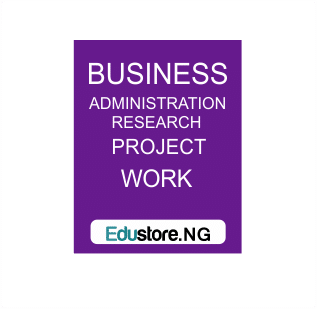The Impact of Physical Distribution Strategies on Organizational Performance
CHAPTER ONE
INTRODUCTION
- BACKGROUND TO THE STUDY
Emergence of physical distribution as a special field of study occurred around 1960s in response to both environmental and conceptual developments.
Physical distribution is the set of activities connected with efficient movement of finished goods from the end of the production operation to the consumer. Physical distribution takes places within numerous wholesaling and retailing distribution channels, and includes such important decision areas as customer services, inventory control, material handing protective packaging order processing transportation warehousing, site location and warehousing. Physical distribution is part of a larger process called “distribution” which includes wholesales and retailing marketing as well as the physical movement of products.
Distribution is a stream, a flow of products and services from the producer through intermediaries, to the end users, (Szopa & Pekata, 2012). Producing products that customers want, pricing them correctly and developing well designed promotional plans are necessary but not sufficient conditions for customer satisfaction. The final part is distribution, the “place” element of the marketing mix. Product need to be available in adequate quantities, in convenient location and at the right time. Distribution can be done directly or indirectly. Direct distribution has to do with the producer selling directly to customers and indirect when a producer sells through intermediaries, ( kotler& keller, 2006).
Physical distribution activities have recently received increasing attention from business managers, including small business owners. This is due to large part to the fact that these functions of ten represent almost half of the fact that these functions of ten represent almost half of total marketing function cost of a product. Impact research studies indicate that physical distribution cost nationally amount to approximately 20% of the country’s total gross national product (GNP). These finding’s have led many business to expand their cost-cutting efforts beyond their historical focus in production to encompass physical distribution activities. The importance of physical distribution is also based on the relevance to customer’s satisfaction. By storing goods in convenient location for shipment to wholesales and retailers and by creating fast, reliable means of moving goods, business owner can help assure continued success in a rapidly changing competitive global market.
The diversity of terms designating the field of study reveals the following tiles physical distribution, physical distribution system, physical distribution management, logistic management, marketing logistics, distribution planning, and principle of logistic management. The fabric of logistic though was a mesh of distribution activities interview with interdisciplinary perspectives.
The list of manageable activities grew include the following: order processing transportation, containerization, manufacturing and converting capacity information flows, storage, freight transportation, market forecasting, supply scheduling packaging, transit insurance, communication control, customer service, materials handling, movement service order processing.
- STATEMENT OF THE PROBLEM
It has been observed that in any organization, physical distribution strategies should be treated as a total unit in order to achieve a sustainable competitive advantage. This therefore calls for organizations to design an appropriate distribution strategy that will carry their products thereby ensuring product availability and market coverage.
However, the problem of this study will attempt to determine the effort of organizations in designing their physical distribution channel whether it is rewarded by increased sales, profitability and sustainable competitive advantage and this study will be considering only physical distribution strategy in the sales of fast moving consumer products.
- OBJECTIVES OF THE STUDY
- To examine whether physical distribution affect the marketing performance of small manufacturing firms in Lagos.
- To ascertain whether physical distribution strategy have impact on the profitability of an organization.
- To find out whether physical distribution strategy helps an organization to gain a sustainable competitive advantage.
- RESEARCH QUESTION
The following research question will be put to empirical finding in this study
- How effective is physical distribution on the marketing performance of small manufacturing firms in Lagos?
- Does physical distribution strategy have positive impact on the
Profitability of an organization?
- Does physical distribution strategy helps an organization to gain a sustainable competitive advantage?
1.5 RESEARCH HYPOTHESIS
This research study aims at testing the following hypotheses:
H0: Physical distribution on the marketing performance of firmse.g Unilever Nigeria Plc. has not been effective.
Hi: Physical distribution on the marketing performance of firm (Unilever Nigeria Plc.) has been effective
H0: Intensive distribution strategy does not have any significant impact on profitability of an organization.
H1: Intensive distribution strategy has significant impact on profitability of an organization.
H0: physical distribution strategy helps an organization to gain a sustainable competitive advantage.
H1: physical distribution strategy does not help an organization to gain sustainable competitive advantage.
1.6 SIGNIFICANCE OF THE STUDY
Remarkably Unilever Nigeria Plc is a major player in the service (commodity market sector of the economy. “UNILEVER NIGERIA PLC” overlies the creation of employment and research investment, the irony of the matter is that so little has been achieved in the area of research and development. The people (manufacturers and managers) fail to recognize an extremely vital role being played by marketing management in a modern economy, for any business concern to have an appropriate picture of the future prospects periodic research is desirable if it is to exploit the opportunities that abound ahead
1.7 THE SCOPE AND DELIMITATION OF THE STUDY
The topic of this research study is the role of physical distribution on the marketing performance of manufacture firms in Lagos e.g Unilever Nigeria Plc. Since it is part of the community market and most of the policies and practice of the members are becoming aggressive in respond of the industry to the new trend, wide investigation of physical distribution on the marketing performance that is desirable and so an attempt will be made to do that.
Due to the constraints, this study will be limited to Lagos office of : Unilever Nigeria Plc” this study will not lay claim to excellence as a result of limited resources, sampling sizes of questionnaires administration will be scale down considerably. Moreover, because of awareness and response in the organization a lot of scepticism will be displayed concerning access to company documents considered as containing vital and classified information.
Finally about the study of physical distribution on the marketing performance vis a vis the element of the marketing mix.
1.8 DEFINITION OF TERMS
For the purpose of this research work, the terms that will be frequently used are as follows:
Distribution: It is the process of making product/services available to customers, in the right place, right quantity and at the right time.
Wholesaling: It includes all marketing activities in which purchases are meant for resale.
Retailing: Marketing activities that is responsible for the selling of goods and services to the final consumers.
Agent: Business units that deals in the negotiations for the buying and selling of goods and services.
Transportation: This refers to the subject of how products will be move from one place to another.
Channel Integration: It is the way in which the players in the channel are linked.
Customer: This refers to the wholesalers and retailers.
Consumer: This refers to the final users in the chain of distribution.
Strategy: It can be defined as the set of decisions taken by management on how the business will allocate its resources and achieve sustainable competitive advantage in its chosen market.
Marketing Strategies: This consists of two district and yet interrelated parts
Target Market: This is a group of customers which has nearly the same characteristics and to which a company .wishes to appeal
Marketing Concept: This is concerned with a firm focusing all its efforts on satisfying its customers, at a profit. This is relying a new philosophy of business, replacing production-oriented philosophy, which focus on organizing firms’ resources to make products and then sell them.
DOWNLOAD COMPLETE PROJECT NOW
DOWNLOAD COMPLETE WORK- For Reference Only: Materials are for research, citation, and idea generation purposes and not for submission as your original final year project work.
- Avoid Plagiarism: Do not copy or submit this content as your own project. Doing so may result in academic consequences.
- Use as a Framework: This complete project research material should guide the development of your own final year project work.
- Academic Access: This platform is designed to reduce the stress of visiting school libraries by providing easy access to research materials.
- Institutional Support: Tertiary institutions encourage the review of previous academic works such as journals and theses.
- Open Education: The site is maintained through paid subscriptions to continue offering open access educational resources.






